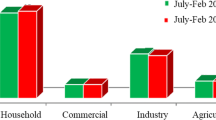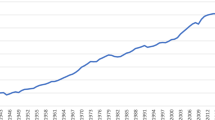Abstract
This paper proposes an adaptive fuzzy expert system to concurrently estimate and forecast both long-term electricity and natural gas (NG) consumptions with hike in prices. Using a novel procedure, the impact of price hike is incorporated into energy demand modeling. Furthermore, adaptive network-based FIS (ANFIS) is used to model NG consumption in power generation (NGPG). To cope with random uncertainty in small historical data sets, Monte Carlo simulation is used to generate training data for ANFIS. The proposed ANFIS uses electricity consumption data to improve the estimation of total NG consumption. The unique contribution of this paper is three fold. First, it proposes a novel expert system for electricity consumption and NG consumption in end-use sector with hike in prices. Second, it uses ANFIS-Monte Carlo approach for NGPG. Third, electricity consumption is used in ANFIS for improvement of NGPG consumption estimation. A real case study is presented that illustrates the applicability and usefulness of the proposed model where it is applied for joint forecasting of annual electricity and NG consumption with hike in prices.












Similar content being viewed by others
Explore related subjects
Discover the latest articles, news and stories from top researchers in related subjects.Notes
R-squared or the coefficient of determination is the percentage of the total variation in the electricity consumption that is explained by the regression model 7.
Having in hand x and x′ as actual and estimated data respectively, the Mean Absolute Percentage Error (MAPE) = 1/n∑ t=1:n [|x t -x′ t |/x t ]. Scaling the output, MAPE method is the most suitable method to estimate the relative error because it accounts for the different scales that may be existed in outputs.
References
Alavi AH, Gandomi AH (2011) A robust data mining approach for formulation of geotechnical engineering systems. Eng Comput 28(3):242–274
Al-Shobaki S, Mohsen M (2008) Modeling and forecasting of electrical power demands for capacity planning. Energy Convers Manag 49(11):3367–3375
Azadeh A, Asadzadeh SM, Ghanbari A (2010) An adaptive network-based fuzzy inference system for short-term natural gas demand estimation: uncertain and complex environments. Energy Policy 38:1529–1536
Azadeh A, Asadzadeh SM, Saberi M, Nadimi V, Tajvidi A, Sheikalishahi M (2011) A neuro-fuzzy-stochastic frontier analysis approach for long-term natural gas consumption forecasting and behavior analysis: the cases of Bahrain, Saudi Arabia, Syria, and UAE. Appl Energy 88:3850–3859
Azadeh A, Ghaderi SF, Sohrabkhani S (2008) A simulated-based neural network algorithm for forecasting electrical energy consumption in Iran. Energy Policy 36(7):2637–2644
Azadeh A, Ghaderi SF, Sohrabkhani S (2008) Annual electricity consumption forecasting by neural network in high energy consuming industrial sectors. Energy Convers Manag 49(8):2272–2278
Azadeh A, Saberi M, Asadzadeh SM (2011) An adaptive network based fuzzy inference system-auto regression-analysis of variance algorithm for improvement of oil consumption estimation and policy making: the cases of Canada, United Kingdom, and South Korea. Appl Math Model 35(2):581–593
Azadeh A, Saberi M, Gitiforouz A, Saberi Z (2009) A hybrid simulation-adaptive network based fuzzy inference system for improvement of electricity consumption estimation. Expert Syst Appl 36(8):11108–11117
Azadeh A, Saberi M, Seraj O (2010) An integrated fuzzy regression algorithm for energy consumption estimation with non-stationary data: a case study of Iran. Energy 35:2351–2366
Bektas Ekici B, Aksoy UT (2011) Prediction of building energy needs in early stage of design by using ANFIS. Expert Syst Appl 38(5):5352–5358
Brown M, Harris C (1994) Neurofuzzy adaptive modeling and control. Prentice Hall, New Jersey
Cheng CH, Wei LY (2010) One step-ahead ANFIS time series model for forecasting electricity loads. Optim Eng 11(2):303–317
Considine TJ (2000) The impacts of weather variations on energy demand and carbon emissions. Resource Energy Econ 22:295–314
Dagher L (2011) Natural gas demand at the utility level: an application of dynamic elasticities. Energy Econ (in press)
Detailed SRIE (2009) Detailed statistical report of Iran electricity industry. http://amar.tavanir.org.ir/
EIA (2011) Energy information administration, International Natural Gas Prices. http://www.eia.gov/emeu/international/gasprice.html
Erdogdu E (2010) Natural gas demand in Turkey. Appl Energy 87(1):211–219
Forouzanfar M, Doustmohammadi A, Menhaj MB, Hasanzadeh S (2010) Modeling and estimation of the natural gas consumption for residential and commercial sectors in Iran. Appl Energy 87:268–274
Ghaffari A, Zare S (2009) A novel algorithm for prediction of crude oil price variation based on soft computing. Energy Econ 31:531–536
Gorucu FB, Gumrah F (2004) Evaluation and forecasting of gas consumption by statistical analysis. Energy Source Part A Recover Util Environ Effects 26(3):267–276
Gutierrez RA, Nafidi R, Gutierrez S (2005) Forecasting total natural-gas consumption in Spain by using the stochastic Gompertz innovation diffusion model. Appl Energy 80:115–124
Hydrocarbori energy balance (2009) Ministry of oil publishing. http://www.iies.ac.ir
IMF (2011) International Monetary Fund website. http://www.imf.org/external/data.htm
Jang JSR (1993) ANFIS: adaptive network based fuzzy inference system. IEEE Trans Syst Man Cybern 23(3):665–683
Jang R, Sun C, Mizutani E (1997) Neuro-fuzzy and soft computation. Prentice Hall, New Jersey
Kalogirou SA (2003) Artificial intelligence for the modeling and control of combustion processes: a review. Prog Energy Combust Sci 29(6):515–566
Kankal M, Akpinar A, Komurcu MI, Ozsahin TS (2011) Modeling and forecasting of Turkey’s energy consumption using socio-economic and demographic variables. Appl Energy 88(5):1927–1939
Khotanzad A, Elragal H, Lu T (2000) Combination of artificial neural-network forecasters for prediction of natural gas consumption. IEEE Trans Neural Netw 11(2):464–473
Kuusisto S, Lehtokangas M, Saarinen J, Kaski K (1997) Short term electric load forecasting using a neural network with fuzzy hidden neurons. Neural Comput Appl 6(1):42–56
Labandeira X, Labeaga JM, López-Otero X (2011) Estimation of elasticity price of electricity with incomplete information. Energy Econ (in press)
Lau HCW, Cheng ENM, Lee CKM, Ho GTS (2008) A fuzzy logic approach to forecast energy consumption change in a manufacturing system. Expert Syst Appl 34(3):1813–1824
Lertpalangsunti N, Chan CW (1998) An architectural framework for the construction of hybrid intelligent forecasting systems: application for electricity demand prediction. Eng Appl Artif Intell 11:549–565
Lijesen MG (2007) The real-time price elasticity of electricity. Energy Econ 29(2):249–258
Liu B (1983) Natural gas price elasticities: variations by region and by sector in the USA. Energy Econ 5(3):195–201
Mamdani EH, Assilian S (1975) An experiment in linguistic synthesis with a fuzzy logic controller. Int J Man Mach Stud 7(1):1–13
Moreno J (2009) Hydraulic plant generation forecasting in Colombian power market using ANFIS. Energy Econ 31:450–455
Parikh J, Purohit P, Maitra P (2007) Demand projections of petroleum products and natural gas in India. Energy 32:1825–1837
Potocˇnika P, Thaler M, Govekar E, Grabeca I, Poredos A (2007) Forecasting risks of natural gas consumption in Slovenia. Energy Policy 35:4271–4282
Reddy BS, Balachandra P (2003) Integrated energy–environment-policy analysis: a case study of India. Utility Policy 11(2):59–73
Sadat Hosseini S, Gandomi A (2012) Short-term load forecasting of power systems by gene expression programming. Neural Comput Appl 21(2):377–389
Sajadi SM, Asadzadeh SM, Majazi Dalfard V, Nazari Asli M, Nazari-Shirkouhi S (2012) A new adaptive fuzzy inference system for electricity consumption forecasting with hike in prices. Neural Comput Appl. doi:10.1007/s00521-012-1197-6
SCI (2011) Statistic Center of Iran. www.sci.org
Shakouri H, Nadimi R, Ghaderi F (2008) A hybrid TSK-FR model to study short-term variations of the electricity demand versus the temperature changes. Expert Syst Appl 36:1765–1772
Siemek J, Nagy S, Rychlicki S (2003) Estimation of natural-gas consumption in Poland based on the logistic-curve interpretation. Appl Energy 75(1–2):1–7
Takagi T, Sugeno M (1985) Fuzzy identification of systems and its application to modeling and control. IEEE Trans Syst Man Cybern 15(1):116–132
Tsukamoto Y (1979) An approach to fuzzy reasoning method. In: Gupta MM, Ragade RK, Yager RR (eds) Advances in fuzzy set theory and application. North-Holland, Amsterdam, pp 137–149
Vondracek J, Pelikan E, Konar O, Cermakova J, Eben K, Maly M, Brabec M (2008) A statistical model for the estimation of natural gas consumption. Appl Energy 85(5):362–370
Yager R, Filev D (1994) Generation of fuzzy rules by mountain clustering. J Intell Fuzzy Syst 2(3):209–219
Zhang X, Mao Y (2009) The relationship between energy consumption and economic growth in china based on ANFIS. International workshop on intelligent systems and applications, ISA 2009, art. no. 5073198
Author information
Authors and Affiliations
Corresponding author
Appendix (MATLAB code for the adaptive combined FIS model)
Appendix (MATLAB code for the adaptive combined FIS model)



Rights and permissions
About this article
Cite this article
Majazi Dalfard, V., Nazari Asli, M., Nazari-Shirkouhi, S. et al. Incorporating the effects of hike in energy prices into energy consumption forecasting: a fuzzy expert system. Neural Comput & Applic 23 (Suppl 1), 153–169 (2013). https://doi.org/10.1007/s00521-012-1282-x
Received:
Accepted:
Published:
Issue Date:
DOI: https://doi.org/10.1007/s00521-012-1282-x




